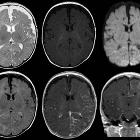Haberland-Syndrom
Encephalocraniocutaneous lipomatosis (ECCL), also known as Haberland syndrome, is a rare congenital neurocutaneous syndrome characterized by unilateral lipomas of the cranium, face, and neck, ipsilateral lipodermoids of the eye, and ipsilateral brain anomalies.
The clinical features of ECCL overlap with other neurocutaneous syndromes.
Radiographic features
- unilateral cerebral hemispheric atrophy ipsilateral to scalp lipoma
- diffuse, ipsilateral leptomeningeal enhancement
- intracranial lipomas
- spinal lipomas/lipomatosis (cervico-thoracic>lumbar)
- polymicrogyria of temporal, parietal and/or occipital lobes
- enlargement of the lateral ventricle, intracranial cysts
History and etymology
The syndrome was first described by Catherine Haberland and Maurice Perou in 1970 .
Siehe auch:
und weiter:

 Assoziationen und Differentialdiagnosen zu Haberland-Syndrom:
Assoziationen und Differentialdiagnosen zu Haberland-Syndrom:

